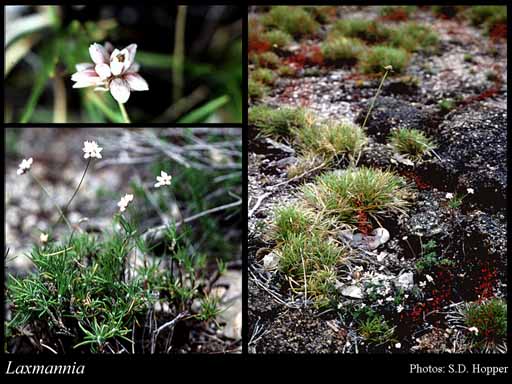- Reference
- Prodr.Fl.Nov.Holland. 285 (1810)
- Name Status
- Current

Scientific Description
Family Anthericaceae.
Sometimes included in Liliaceae.
Habit and leaf form. Herbs (tufted or diffuse); evergreen, or deciduous. Perennial. Leaves basal (B), or cauline (or terminal). Plants with a basal concentration of leaves, or with neither basal nor terminal concentrations of leaves; rhizomatous. Self supporting, or climbing. Mesophytic, or xerophytic. Leaves alternate; spiral, or distichous; ‘herbaceous’, or leathery, or membranous; sessile; sheathing. Leaf sheaths not tubular; with free margins. Leaves edgewise to the stem, or with ‘normal’ orientation; simple. Leaf blades entire; solid; terete (to triquetrous), or solid/angular (trigonous, or channelled); linear, or lanceolate, or oblong, or ovate; linear (to filiform), or ovate; parallel-veined; without cross-venules; sheathing, closely appressed to stems and branches, scarious to finely divided, woolly hairy or not woolly hairy, produced into an apical or subapical filiform appendage. Leaves ligulate, or eligulate; without stipules. Leaf blade margins entire. Leaf anatomy. Extra-floral nectaries absent. Stem anatomy. Secondary thickening absent. Roots. Aerial roots present (stilt roots), or absent.
Reproductive type, pollination. Fertile flowers hermaphrodite. Unisexual flowers absent. Plants hermaphrodite. Floral nectaries present. Nectar secretion from the gynoecium (from septal nectaries).
Inflorescence and flower features. Flowers aggregated in ‘inflorescences’; in heads (PB), or in umbels (, head-like). The terminal inflorescence unit cymose, or racemose (simple or compound). Inflorescences scapiflorous; terminal, or axillary; inflorescence sessile or pedunculate, several to many flowered; with involucral bracts (shorter than or not shorter than the perianth, imbricate, chartaceous, scarious; outer bracts conspicuous, entire, empty, usually brown); pseudanthial, or not pseudanthial. Flowers pedicellate (shortly), or sessile (sessile or nearly so); bracteate (1 subtends each flower, usually white, thin, transparent, jagged to finely divided margins often resulting in woolly hairs); small, or medium-sized; regular; 3 merous; cyclic; pentacyclic, or tetracyclic. Perigone tube absent (in the normal sense). Perianth with distinct calyx and corolla (the whorls rather different), or of ‘tepals’; 6; 2 -whorled (3+3); isomerous; partially joined (then the inner members joined), or free; petaloid; similar in the two whorls, or different in the two whorls; green, or white, or red (reddish), or pink. Calyx (if the outer whorl so interpreted) 3; 1 -whorled; regular. Corolla (if the inner whorl so interpreted) 3; 1 -whorled; regular. Corolla members sometimes fringed. Androecial members definite in number. Androecium 6. Androecial members adnate; all equal, or markedly unequal; free of one another; 1 -whorled, or 2 -whorled. Androecium exclusively of fertile stamens, or including staminodes. Staminodes when present, 3. Stamens 6 (in 2 whorls); all more or less similar in shape; isomerous with the perianth, or diplostemonous; those opposite the outer segments inserted at the top of the perianth tube; those opposite the inner segments inserted near the middle of the segments; alterniperianthial, or oppositiperianthial. Anthers dorsifixed (near the base or the middle); versatile; dehiscing via longitudinal slits; introrse; the 2 cells parted above and below the point of attachment; tetrasporangiate. Gynoecium 3 carpelled. The pistil 3 celled. Carpels isomerous with the perianth. Gynoecium syncarpous; synstylovarious, or eu-syncarpous; superior. Ovary plurilocular; 3 locular; almost stipitate, contracted at the base. Gynoecium stylate. Styles 1; apical. Stigmas 1; 2–3 - lobed. Placentation axile. Ovules 1–8 per locule; arillate, or non-arillate; campylotropous (generally), or anatropous.
Fruit and seed features. Fruit non-fleshy; dehiscent; usually a capsule. Capsules loculicidal. Fruit 3 celled; 3–12 seeded. Seeds endospermic. Cotyledons 1. Embryo straight to curved.
Taxonomic Literature
- Wheeler, Judy; Marchant, Neville; Lewington, Margaret; Graham, Lorraine 2002. Flora of the south west, Bunbury, Augusta, Denmark. Volume 1, introduction, keys, ferns to monocotyledons. Australian Biological Resources Study.. Canberra..